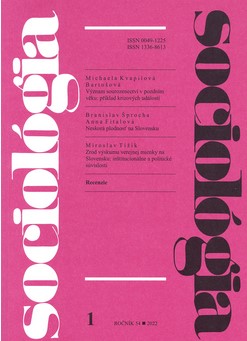Neskorá plodnosť na Slovensku
Late Fertility in Slovakia
Author(s): Branislav Šprocha, Anna FitalováSubject(s): Social history, Demography and human biology, Transformation Period (1990 - 2010), Present Times (2010 - today)
Published by: SAV - Slovenská akadémia vied - Sociologický ústav
Keywords: Late fertility; fertility postponement; demographic transition; Slovakia;
Summary/Abstract: Postponement of childbearing and age pluralization of reproduction are the main features of the transformational changes in the fertility process in Slovakia in the last three decades. The advanced reproductive age is increasingly used for the realization of reproductive intentions and, therefore, this paper evaluates long-term trends in fertility at age 35 and over and its significance for overall fertility within the context of changes that took place after 1989. The results confirm an increase in the level of and in the contribution of late fertility to the overall reproduction in Slovakia. However, this trend has stagnated in recent years and the level and contribution of late motherhood to oveall fertility lags significantly behind the situation observed in the interwar period. Futher, the paritystructure of late childbearing has transformed. We find that the contribution of second and higher parity births has been reduced in favour of first births. With respect to non-maital childbearing, we find that it is below average in the advanced reproductive ages, in spite of rapid increase of overall share of non-marital births in the past 30 years. We use differential analysis of the late fertility to investigate trends in population subgroups. The intensity of late childbearing has increased regardless of marital status, educational attainment, ethnicity or place of residence of the mother. At the same time, however, there was a certain divergence between the observed groups of women. Late motherhood is thus associated primarily with never-married and married women, with those having lowest and highest educational attanments, of Slovak ethnicity and with those permanently resident in the urban environment, particularly in the largest cities and, consequently, in the Bratislava region.
Journal: Sociológia - Slovak Sociological Review
- Issue Year: 54/2022
- Issue No: 1
- Page Range: 26-52
- Page Count: 27
- Language: Slovak

